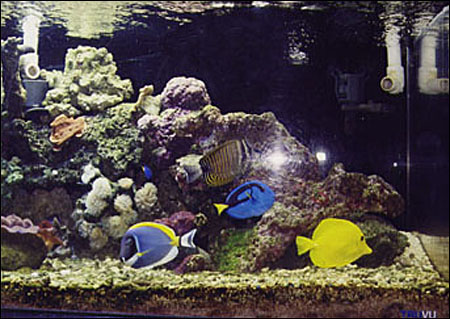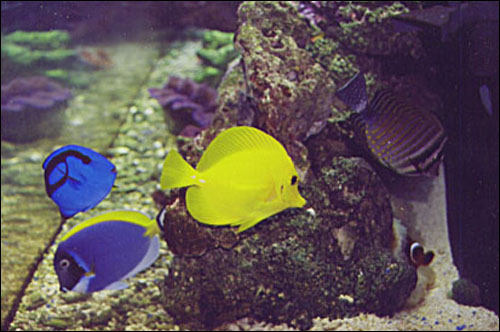 Fish
4 Tangs (Blue, Yellow, Powder Blue, and Red Sea Sail Fin), 1 Mandarin Gobi, 1 Pajama Cardinal, 1 Damsel, 1 Clown
Fish
4 Tangs (Blue, Yellow, Powder Blue, and Red Sea Sail Fin), 1 Mandarin Gobi, 1 Pajama Cardinal, 1 Damsel, 1 Clown Saltwater tanks require regular maintenance. Water changes should be made at 25% of the total water volume at least 3 times a month or smaller changes once a week. You cannot add the salt mixture directly into the tank as this will create higher salt content and kill the fish. You will need a large Rubbermaid trash container to store the water in and add the salt mixture as directed. Keep water movement flowing with a bubbler for a few days to allow the mix to dissolve. A heater should be inserted as well to maintain temperature before you add the mixture into the tank.
Saltwater tanks require regular maintenance. Water changes should be made at 25% of the total water volume at least 3 times a month or smaller changes once a week. You cannot add the salt mixture directly into the tank as this will create higher salt content and kill the fish. You will need a large Rubbermaid trash container to store the water in and add the salt mixture as directed. Keep water movement flowing with a bubbler for a few days to allow the mix to dissolve. A heater should be inserted as well to maintain temperature before you add the mixture into the tank. The set-up of a tank itself would also require a chiller in warmer climates. A chiller cools down the temperature of the water since the compact florescent lights heat it up. With Arizona's temperatures reaching 90 degrees or more it is far more difficult to maintain cooler water temperatures unless the AC is constantly running to ensure cool ambient temperatures. It's best to have a chiller just in case the AC fails.
The set-up of a tank itself would also require a chiller in warmer climates. A chiller cools down the temperature of the water since the compact florescent lights heat it up. With Arizona's temperatures reaching 90 degrees or more it is far more difficult to maintain cooler water temperatures unless the AC is constantly running to ensure cool ambient temperatures. It's best to have a chiller just in case the AC fails.